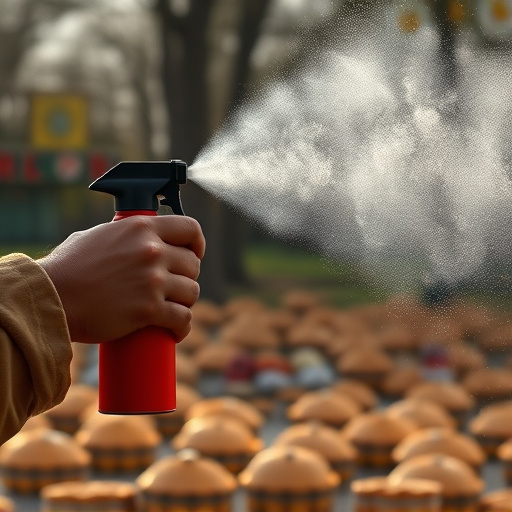Proper storage of pepper spray in cars is essential for maintaining its potency and effectiveness during emergencies. Keep it away from direct sunlight and heat sources in cool, dry places like glove compartments or under seats. Store in original packaging or child-proof containers to prevent accidental activation and contamination. Follow local regulations and use optimized application techniques focusing on the face and eyes for strategic deployment in law enforcement and self-defense.
“In today’s world, understanding police-grade inflammatory pepper spray compound is crucial for personal safety and legal compliance. This article delves into the intricate composition and varying strengths of pepper spray, offering insights that could save lives. We explore legal frameworks governing the carrying of such devices, emphasizing responsible ownership. Furthermore, safe storage practices are highlighted to ensure optimal effectiveness, with a special focus on practical tips for those storing pepper spray in their cars. Prepare to navigate emergency situations with newfound confidence.”
- Understanding Pepper Spray Composition and Strength
- Legal Considerations for Carrying Pepper Spray
- Safe Storage Practices for Optimal Effectiveness
- Effective Use Strategies in Emergency Situations
Understanding Pepper Spray Composition and Strength
Pepper spray is a powerful law enforcement tool designed to incapacitate individuals temporarily through irritation and pain, allowing officers to gain control during various situations. Understanding its composition and strength is key to assessing its effectiveness and safety. The primary active ingredient in most pepper sprays is capsaicin, derived from chili peppers. This compound stimulates nerve endings, causing an intense burning sensation and temporary blindness.
The potency of pepper spray is measured in capsicum units (CU), with higher CU indicating greater strength. Storage of pepper spray in cars, or any vehicle, requires careful consideration due to its volatile nature. It’s crucial to keep the spray in a secure location, away from direct sunlight and heat sources, as these factors can degrade its effectiveness over time. Proper storage ensures that when needed, especially during emergency situations, the pepper spray retains its full power, providing officers with the necessary tools for crowd control and self-defense.
Legal Considerations for Carrying Pepper Spray
In many jurisdictions, carrying pepper spray for self-defense is legal as long as individuals comply with specific regulations. One significant consideration is the type and concentration of the compound used. Pepper spray designed for law enforcement use typically contains a higher percentage of capsaicin, making it more potent. While this offers enhanced protection, it also raises concerns about misuse and accidental exposure.
Storage plays a crucial role in legal considerations. Pepper spray must be kept securely and out of reach of unauthorized individuals, especially when stored in a car. Many areas have specific rules regarding pepper spray storage in vehicles, emphasizing the need for child-proof containers or locked compartments to prevent accidental discharge and minimize the risk of misuse. Proper storage not only ensures compliance with the law but also promotes safety for all users.
Safe Storage Practices for Optimal Effectiveness
Proper storage of pepper spray is essential to maintain its optimal effectiveness and ensure it remains ready for immediate use when needed. When storing pepper spray, especially in a vehicle, keep it in a cool, dry place away from direct sunlight or extreme temperature fluctuations. The interior dashboard is often recommended as a storage location, but consider areas with lower temperatures, such as the glove compartment or under seats, to prevent damage and maintain potency.
Additionally, protect the spray from potential contaminants by storing it in its original packaging or a secure container. Avoid exposing it to moisture or water, as these elements can compromise the integrity of the compound. Always ensure that the storage area is child-safe and secured to prevent accidental activation or access. Regularly check the expiration date and condition of your pepper spray to guarantee maximum potency and reliability when required for self-defense or law enforcement purposes.
Effective Use Strategies in Emergency Situations
In emergency situations, effectively deploying pepper spray can be a game-changer for law enforcement and citizens alike. Strategizing its use requires training, clarity of purpose, and awareness of surrounding conditions.
For instance, storing pepper spray strategically in cars, easily accessible yet secure, enables officers to respond quickly during high-risk encounters or traffic stops. Proper procedures for application – aimed at the face, eyes, and nose – maximize its effectiveness while minimizing off-target effects. Remembering that pepper spray temporarily incapacitates rather than permanently injures is crucial for de-escalation and ensuring public safety.
Pepper spray is a powerful tool for personal safety, but its effectiveness depends on understanding composition, legal carry options, and safe storage practices. By adhering to optimal storage guidelines, ensuring legal compliance, and employing effective use strategies, individuals can maximize the reliability of their pepper spray—especially when stored in a car for quick access during emergencies. Remember, knowledge and preparation are key to staying safe while on the go.
